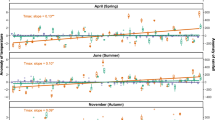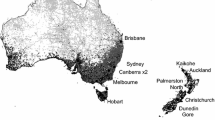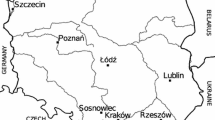Abstract
The drivers of spatial variation in ragweed pollen concentrations, contributing to severe allergic rhinitis and asthma, are poorly quantified. We analysed the spatiotemporal variability in 16-year (1995–2010) annual total (66 stations) and annual total (2010) (162 stations) ragweed pollen counts and 8 independent variables (start, end and duration of the ragweed pollen season, maximum daily and calendar day of the maximum daily ragweed pollen counts, last frost day in spring, first frost day in fall and duration of the frost-free period) for Europe (16 years, 1995–2010) as a function of geographical coordinates. Then annual total pollen counts, annual daily peak pollen counts and date of this peak were regressed against frost-related variables, daily mean temperatures and daily precipitation amounts. To achieve this, we assembled the largest ragweed pollen data set to date for Europe. The dependence of the annual total ragweed pollen counts and the eight independent variables against geographical coordinates clearly distinguishes the three highly infected areas: the Pannonian Plain, Western Lombardy and the Rhône-Alpes region. All the eight variables are sensitive to longitude through its temperature dependence. They are also sensitive to altitude, due to the progressively colder climate with increasing altitude. Both annual total pollen counts and the maximum daily pollen counts depend on the start and the duration of the ragweed pollen season. However, no significant changes were detected in either the eight independent variables as a function of increasing latitude. This is probably due to a mixed climate induced by strong geomorphological inhomogeneities in Europe.






Similar content being viewed by others
References
Andersen TB (1991) A model to predict the beginning of the pollen season. Grana 30:269–275
ARIA (Allergic Rhinitis and its Impact on Asthma) (2008) Update. In collaboration with the World Health Organization, GA2LEN and AllerGen. http://www.whiar.org/docs/ARIA-Report-2008.pdf
Ariano R, Canonica GW, Passalacqua G (2010) Possible role of climate changes in variations in pollen seasons and allergic sensitizations during 27 years. Ann Allergy Asthma Immunol 104:215–222
Asher MI, Montefort S, Björkstén B, CKW L, Strachan DP, Weiland SK, the ISAAC Phase Three Study Group et al (2006) Worldwide time trends in the prevalence of symptoms of asthma, allergic rhinoconjunctivitis, and eczema in childhood: ISAAC phases one and three repeat multicountry cross-sectional surveys. Lancet 368(9537):733–743
Béres I, Novák R, Hoffmanné Pathy ZS, Kazinczi G (2005) Az ürömlevelű parlagfű (Ambrosia artemisiifolia L.) elterjedése, morfológiája, biológiája, jelentősége és a védekezés lehetőségei. [Distribution, morphology, biology and importance of common ragweed (Ambrosia artemisiifolia L.) and protection facilities.] Gyomnövények. Gyomirtás 6:1–48 (in Hungarian)
Bonini M, Pini A, Travaglini A, Ugolotti M, Voltolini S, Zanca M et al (2014) Diffusion and trend of ragweed pollen in Italy. Third International Ragweed Conference, April 3rd–4th, 2014, Rho (Milan), Italy, Session VI, poster, p. 65. Ambrosia day, 2014—Ragweed allergy: 15 years of prevention. April 4th, 2014, Rho (Milan), Italy. Eur J Aerobiol Environ Med 2:65 (Official Journal of AIA-ISDE)
Bora GY, Nemerkényi A (1994) Magyarország földrajza. (Geography of Hungary). Nemzeti Tankönyvkiadó, Budapest (in Hungarian)
Bullock JM, Chapman D, Schafer S, Roy D, Girardello M, Haynes T et al (2010) Assessing and controlling the spread and the effects of common ragweed in Europe. Final report: ENV.B2/ETU/2010/0037. Natural Environment Research Council, UK 456 p. https://circabc.europa.eu/sd/d/d1ad57e8-327c-4fdd-b908-dadd5b859eff/FinalFinalReport.pdf
Burbach GJ, Heinzerling LM, Röhnelt C, Bergmann KC, Behrendt H, Zuberbier T (2009) Ragweed sensitization in Europe—GA2LEN study suggests increasing prevalence. Allergy 64:664–665
Cecchi L, Testi S, Campi P, Orlandini S (2010) Long-distance transport of ragweed pollen does not induce new sensitizations in the short term. Aerobiologia 26:351–352
Chapman DS, Haynes T, Beal S, Essl F, Bullock JM (2014) Phenology predicts the native and invasive range limits of common ragweed. Glob Chang Biol 20:192–202
Chapman DS, Makra L, Albertini R, Bonini M, Páldy A, Rodinkova V et al (2016) Modelling the introduction and spread of non-native species: international trade and climate change drive ragweed invasion. Glob Chang Biol 22:3067–3079
Charalampopoulos A, Damialis A, Tsiripidis I, Mavrommatis T, Halley JM, Vokou D (2013) Pollen production and circulation patterns along an elevation gradient in Mt Olympos (Greece) National Park. Aerobiologia 29:455–472
Chauvel B, Dessaint F, Cardinal-Legrand C, Bretagnolle F (2006) The historical spread of Ambrosia artemisiifolia L. in France from herbarium records. J Biogeogr 33:665–673
Chun YJ, Le Corre V, Bretagnolle F (2011) Adaptive divergence for a fitness-related trait among invasive Ambrosia artemisiifolia populations in France. Mol Ecol 20:1378–1388
Cunze S, Leiblein MC, Tackenberg O (2013) Range expansion of Ambrosia artemisiifolia in Europe is promoted by climate change. Ecology Article ID 610126
Dahl Å, Galán C, Hajkova L, Pauling A, Sikoparija B, Smith M et al 2013 The onset, course and intensity of the pollen season. In: Allergenic pollen. A review of the production, release, distribution and health impacts. pp 29–70
D'Amato G, Liccardi G, D'Amato M, Holgate S (2005) Environmental risk factors and allergic bronchial asthma. Clin Exp Allergy 35:1113–1124
Déchamp C, Rimet ML, Méon H, Deviller P (1997) Parameters of ragweed pollination in the Lyon’s area (France) from 14 years of pollen counts. Aerobiologia 13:275–279
Deen W, Hunt T, Swanton CJ (1998) Influence of temperature, photoperiod, and irradiance on the phenological development of common ragweed (Ambrosia artemisiifolia). Weed Sci 46:561–568
Essl F, Dullinger S, Kleinbauer I (2009) Changes in the spatio-temporal patterns and habitat preferences of Ambrosia artemisiifolia during its invasion of Austria. Preslia 81:119–133
Frenz DA (2001) Interpreting atmospheric pollen counts for use in clinical allergy: allergic symptomology. Ann Allergy Asthma Immunol 86:150–157
Frenz DA, Palmer MA, Hokanson JM, Scamehorn RT (1995) Seasonal characteristics of ragweed pollen dispersal in the United States. Ann Allergy Asthma Immunol 75:417–422
Galán C, Cariňanos P, García-Mozo H, Alcázar P, Domínguez-Vilches E (2001) Model for forecasting Olea europaea L. airborne pollen in South-West Andalusia, Spain. Int J Biometeorol 45:59–63
Galán C, Smith M, Thibaudon M, Frenguelli G, Oteros J, Gehrig R, EAS QC Working Group et al (2014) Pollen monitoring: minimum requirements and reproducibility of analysis. Aerobiologia 30(4):385–395
Gellert W, Gottwald S, Hellwich M, Kästner H, Küstner H (1989) The VNR concise encyclopedia of mathematics, 2nd ed., Chapter 12. Van Nostrand Reinhold, New York
Gladieux P, Giraud T, Kiss L, Genton BJ, Jonot O, Shykoff JA (2011) Distinct invasion sources of common ragweed (Ambrosia artemisiifolia) in Eastern and Western Europe. Biol Invasions 13:933–944
Hamaoui-Laguel L, Vautard R, Liu L, Solmon F, Viovy N, Khvorostyanov D et al (2015) Effects of climate change and seed dispersal on airborne ragweed pollen loads in Europe. Nat Clim Chang 5:766–772
Harsányi E (2009) Parlagfű és allergia. (Ragweed and allergy). Növényvédelem 45:454–458 (in Hungarian)
Hirst JM (1952) An automatic volumetric spore trap. Ann Appl Biol 39:257–265
Horváth F, Dobolyi ZK, Morschhauser T, Lőkös L, Karas L, Szerdahelyi T (1995) FLÓRA adatbázis 1.2. (Flora database 1.2.) MTA-ÖBKI, Vácrátót. 267 p. (in Hungarian)
IPCC, Intergovernmental Panel on Climate Change (2013) Summary for policymakers. Climate change 2013. In: Stocker TF, Qin D, Plattner GP, MMB T, Allen SK, Boschung J et al (eds) The physical science basis. Contribution of working group I to the fifth assessment report of the intergovernmental panel on climate change. Cambridge University Press, Cambridge
Jochner S, Ziello C, Boc A, Estrella N, Buters J, Weichenmeier I et al (2012) Spatio-temporal investigation of flowering dates and pollen counts in the topographically complex Zugspitze area on the German-Austrian border. Aerobiologia 28:541–556
Kadocsa E, Juhász M (2002) Study of airborne pollen composition and allergen spectrum of hay fever patients in South Hungary (1990-1999). Aerobiologia 18:203–209
Kadocsa E, Bittera L, Juhász M (1991) Pollenszámlálás alapján végzett bőrtesztek eredményei nyárvégi szezonalitású rhinitis allergicás betegeken. (Results of pollen count related skin prick tests on patients suffering in rhinitis allergy in the post summer season). Orv Hetil 32:1589–1591 (in Hungarian)
Käpylä M, Penttinen A (1981) An evaluation of the microscopial counting methods of the tape in Hirst–Burkard pollen and spore trap. Grana 20:131–141
Karrer G, Skjøth CA, Šikoparija B, Smith M, Berger U, Essl F (2015) Ragweed (Ambrosia) pollen source inventory for Austria. Sci Total Environ 523:120–128
Krämer U, Koch T, Ranft U, Ring J, Behrendt H (2000) Traffic-related air pollution is associated with atopy in children living in urban areas. Epidemiology 11:64–70
Kumar M (1988) World geodetic system 1984: a modern and accurate global reference frame. Mar Geod 12:117–126
Laaidi M, Chinet T, Aegerter P (2011) Allergies au pollen, pollution et climat: revue de la littérature. (Pollen allergies, pollution and climate: literature review). Rev Fr Allergol 51:622–628 (in French)
Leiblein-Wild MC, Tackenberg O (2014) Phenotypic variation of 38 European Ambrosia artemisiifolia populations measured in a common garden experiment. Biol Invasions 16:2003–2015
Lu Z, Chen X (2002) Spatial nonparametric regression estimation: non-isotropic case. Acta Math Aplicatae Sin Engl Ser 18:641–656
Makra L, Juhász M, Béczi R, Borsos E (2005) The history and impacts of airborne Ambrosia (Asteraceae) pollen in Hungary. Grana 44:57–64
Makra L, Sánta T, Matyasovszky I, Damialis A, Karatzas K, Bergmann KC et al (2010) Airborne pollen in three European cities: detection of atmospheric circulation pathways by applying three-dimensional clustering of backward trajectories. J Geophys res-Atmos 115:D24220. doi:10.1029/2010JD014743
Makra L, Matyasovszky I, Tusnády G, Ziska LH, Csépe Z, Nyúl LG et al (2015) Airborne ragweed pollen in Europe: maps of ragweed pollen concentrations and ragweed pollen related characteristics based on the largest data sets. Manuscript
Mihály B, Botta-Dukát Z, (eds.) (2004) Biológiai inváziók Magyarországon. Özönnövények. (Biological invasions in Hungray. Invasive plants.) A KvVM Természetvédelmi Hivatalának Tanulmánykötetei 9. (Series of the Ministry of Environment and Water 9.) TermészetBÚVÁR Alapítvány Kiadó, Budapest (in Hungarian)
Nikolić T, Mitić B, Milašinović B, Jelaska SD (2013) Invasive alien plants in Croatia as a threat to biodiversity of South-Eastern Europe: distributional patterns and range size. CR Biol 336:109–121
Nilsson S, Persson S (1981) Tree pollen spectra in the Stockholm region (Sweden), 1973-1980. Grana 20:179–182
Oswalt ML, Marshall GD (2008) Ragweed as an example of worldwide allergen expansion. Allergy Asthma Clin Immunol 4:130–135
Peterson B, Saxon A (1996) Global increases in allergic respiratory disease: the possible role of diesel exhaust particles. Ann Allergy Asthma Immunol 77:263–270
Pyšek P, Chytrý M, Pergl J, Sadlo J, Wild J (2012) Plant invasions in the Czech Republic: current state, introduction dynamics, invasive species and invaded habitats. Preslia 84:575–629 Special Issue: SI
Recio M, Docampo S, García-Sánchez J, Trigo MM, Melgar M, Cabezudo B (2010) Influence of temperature, rainfall and wind trends on grass pollination in Malaga (western Mediterranean coast). Agric for Meteorol 150:931–940
Reznik SY (2009) L'ambroisie à feuilles d'armoise (Ambrosia artemisiifolia L.) en Russie: propagation, distribution, abondance, dangerosité et mesures de contrôle (Common ragweed (Ambrosia artemisiifolia L.) in Russia: spread, distribution, abundance, harmfulness, and control measures). Ambrosie 26:88–97 (in French)
Rodinkova VV (2014) Airborne pollen spectrum of Dnіpropetrovsk city as a basis of hay fever control. Visnyk of Dnipropetrovsk University. Biol Med 3(106):3–9
Rodinkova V, Palamarchuk O, Kremenska L (2012) The most abundant Ambrosia pollen count is associated with the southern, eastern and the northern-eastern Ukraine. Alergol Immunol 9(2–3):181
Rodríguez-Rajo FJ, Aira MJ, Fernández-González M, Seijo C, Jato V (2011) Recent trends in airborne pollen for tree species in Galicia, NW Spain. Clim res 48:281–291
Rogers C, Wayne PM, Macklin EA, Muilenberg ML, Wagner CJ, Epstein PR et al (2006) Interaction of the onset of spring and elevated atmospheric CO2 on ragweed (Ambrosia artemisiifolia L.) pollen production. Environ Health Perspect 114(6):865–869
Siegal S, Castellan NJ Jr (1998) Nonparametric statistics for the behavioral sciences, 2nd edn. McGraw-Hill, New York ISBN 0–07–057357-3
Silvers WS, Ledoux RA, Dolen WK, Morrison MR, Nelson HS, Weber RW (1992) Aerobiology of the Colorado Rockies—pollen count comparisons between Vail and Denver, Colorado. Ann Allergy 69:421–426
Sinnott RW (1984) Virtues of the Haversine. Sky Telescope 68(2):159
Skjøth CA, Smith M, Šikoparija B, Stach A, Myszkowska D, Kasprzyk I et al (2010) A method for producing airborne pollen source inventories: an example of Ambrosia (ragweed) on the Pannonian Plain. Agric for Meteorol 150:1203–1210
Smith M, Jäger S, Berger U, Šikoparija B, Hallsdottir M, Saulienė I et al (2014) Geographic and temporal variations in pollen exposure across Europe. Allergy 69:913–923
Storkey J, Stratonovitch P, Chapman DS, Vidotto F, Semenov MA (2014) A process-based approach to predicting the effect of climate change on the distribution of an invasive allergenic plant in Europe. PLoS One 9(2):e88156. doi:10.1371/journal.pone.0088156
Thibaudon M, Monnier S (2015) European Information pollen trap. RNSA, Réseau National De Surveillance Aérobiologique, pp 1–13. (http://www.pollenstiftung.de/fileadmin/pid/images/news/EuropeanInformationPolleTrap-5_April_2015.pdf)
Thibaudon M, Šikoparija B, Oliver G, Smith M, Skjøth CA (2014) Ragweed pollen source inventory for France—the second largest centre of Ambrosia in Europe. Atmos Environ 83:62–71
Ziello C, Sparks TH, Estrella N, Belmonte J, Bergmann KC, Bucher E et al (2012) Changes to airborne pollen counts across Europe. PLOS One 7(4):e34076. doi:10.1371/journal.pone.0034076
Zink K, Vogel H, Vogel B, Magyar D, Kottmeier C (2012) Modeling the dispersion of Ambrosia artemisiifolia L. pollen with the model system COSMO-ART. Int J Biometeorol 56:669–680
Ziska LH (2014) Crop systems and global change laboratory, USDA-ARS, Beltsville, Maryland, USA. In: Ziska LH, Dukes JS (eds) Invasive species and global climate change. Part IV. Management: control and adaptation. Climate, CO2 and invasive weed management. Chapter 18. CAB International, Wallingford, pp 293–304
Ziska LH, Beggs PJ (2012) Anthropogenic climate change and allergen exposure: the role of plant biology. Allergy Clin Immunol 129:27–32
Ziska LH, George K, Frenz DA (2007) Establishment and persistence of common ragweed (Ambrosia artemisiifolia L.) in disturbed soil as a function of an urban-rural macro-environment. Glob Chang Biol 13:266–274
Ziska L, Knowlton K, Rogers C, Dalan D, Tierney N, Elder MA (2011) Recent warming by latitude associated with increased length of ragweed pollen season in central North America. Proc Natl Acad Sci U S A 108:4248–4251
Acknowledgements
The authors would like express their thanks to Lewis H. Ziska (Crop Systems and Global Change Laboratory, Agricultural Research Service, United States Department of Agriculture, Beltsville, MD, USA) for his valuable advice and suggestions. The authors would also like to thank Tamás Göbölyös Bozsák (University of Szeged, Faculty of Agriculture, Hódmezővásárhely, Hungary) for his useful help. Lastly, the authors would like to thank the European Aeroallergen Network (EAN, https://ean.polleninfo.eu/Ean) for providing ragweed pollen data for Europe, and the Italian Association of Aerobiology for providing pollen data for Italy.
Author information
Authors and Affiliations
Corresponding author
Additional information
In memoriam István Matyasovszky
Appendix
Appendix
Rights and permissions
About this article
Cite this article
Matyasovszky, I., Makra, L., Tusnády, G. et al. Biogeographical drivers of ragweed pollen concentrations in Europe. Theor Appl Climatol 133, 277–295 (2018). https://doi.org/10.1007/s00704-017-2184-8
Received:
Accepted:
Published:
Issue Date:
DOI: https://doi.org/10.1007/s00704-017-2184-8




